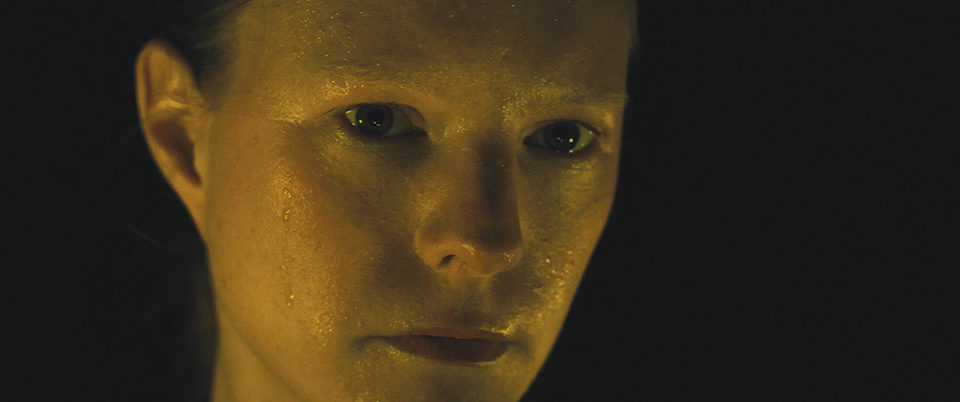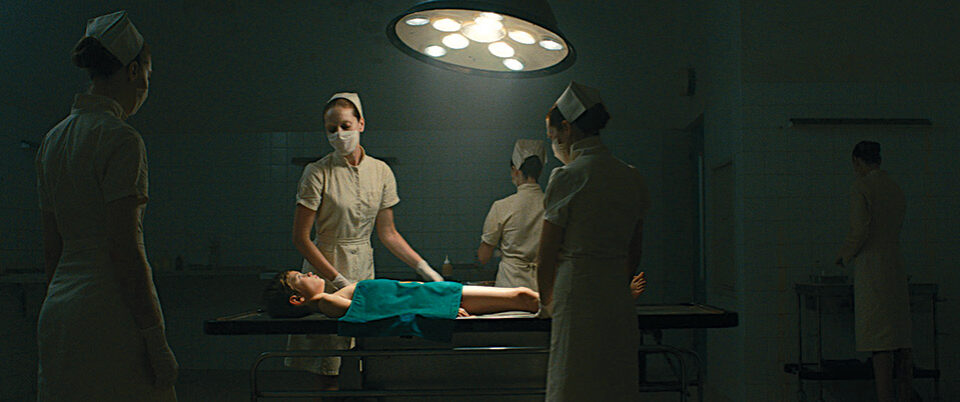By Laura Kern in the May-June 2016 Issue

The Miracle of Life
With Evolution, Lucile Hadzihalilovic dives deep into the murky (and dangerous) waters of maturing and achieving self-knowledge
With two meticulously framed, painterly feature films, Lucile Hadzihalilovic has put a fascinating, unsettling spin on adolescence. Her dreamy, attention-grabbing 2004 debut, Innocence, is set in a faraway ballet school, where young girls are enrolled and trained under highly ambiguous conditions. Like those potentially imprisoned students, the boys who inhabit Hadzihalilovic’s follow-up, Evolution—over a decade in the coming—are emblematic of the pain and mystery of growing up, their worlds unfolding in distant, alien-like settings, with no control over their destinies. But it’s only the film’s protagonist, Nicolas, who doesn’t stand back and accept his fate, questioning his whereabouts as well as pondering the usual existential concerns that arise as one engages deeper with life—who am I? where did I come from? where am I going?—but in Hadzihalilovic’s twisted universe, the answers, if that word can even be used, are highly unforeseen.

From the May-June 2016 Issue
Also in this issue
Evolution opens with some stunning underwater scenery (photographed by Belgian DP on the rise Manuel Dacosse) that rivals any nature doc. But what begins as bright and beautiful, a world bathed in sunlight peering beneath the water’s surface, quickly turns sinister when we are introduced to Nicolas (played by promising newcomer Max Brebant), swimming peacefully alone, as he catches sight of a boy’s dead body on the ocean floor.
The perfectly chiseled Aryan youth of Evolution live on a small desolate island, occupied only by boys on the cusp of puberty and androgynous, automaton-like women (their “mothers” and caregivers, as well as something way more alarming, partly revealed by their freaky nighttime rituals on the beach). Nicolas’s mommy figure (Julie-Marie Parmentier) tells him that the corpse he claims to have glimpsed was in fact just a starfish—a creature with unusual reproductive capabilities, which provides Nicolas with a subject for his drawings and accounts for much of the film’s symbolism. (It’s no spoiler to say that in a film with the deceptively simple title of Evolution, any normal notion of “human evolution” is turned completely inside out.)

The sickly boys, sadly deprived of their carefree days of childhood, are subjected to strange medical experiments and surgical procedures, pumped with unknown drugs and fed slimy meals under strict surveillance, and suffer from frequent bloody noses and the fear that they are fatally ill, told only that they are under treatment because as they get older their bodies will change and weaken. Nicolas knows they are being lied to and wants to find out the truth, and a nurse (Roxane Duran) who takes a (creepily sexual) liking to Nicolas, helps him on that quest of discovery.
Similar to Innocence, whose soundtrack relies heavily on a nature-inspired score comprised of chirping crickets and tweeting birds, Evolution, in order to set its enormously atmospheric and eerie mood, employs the sounds of crashing waves, flowing water, and rustling wind in place of music, which perfectly complements the film’s naturalistic yet fantastical glow (its look is inspired by the Surrealist Italian painter Giorgio de Chirico; the stark compositions took cues from select 1960s Japanese Cinemascope movies). Water is omnipresent throughout, in part, as Hadzihalilovic says, representing the “maternal waters” that many maturing youngsters find difficult to escape. While the setting may bring to mind Joseph Losey’s radioactive-children drama These Are the Damned (63) or Narcisco Ibáñez Serrador’s killer-kids-on-a-remote-island horror flick Who Can Kill a Child? (76), the virtuoso writer-director’s story and vision feels like something all her own.
Whether categorized as sci-fi allegory, surreal body horror, medical thriller, melancholy coming-of-age tale, or, in France, un film fantastique, Evolution is spellbinding from its magical first second to its enigmatic last.
FILM COMMENT spoke to Hadzihalilovic about the creation of the film—and why it took so long!—at last year’s Toronto Film Festival, in her first interview following its world premiere.—Laura Kern
INTERVIEW BY NICOLAS RAPOLD
How did the idea for the movie come to be?
I started to think about it a long, long, long time ago. Even before Innocence. At that time the heart of the project was the hospital. And the mother and the child, maybe 10 years old, on the verge of becoming a teenager. And her not wanting him to go away, and hoping to keep him a child. Then I read the short story that became Innocence,so I jumped on that first. Then I wanted to go back to this, which was, for me, a horror movie. Through the experience of Innocence, [my concept of Evolution] changed a bit. I also didn’t want to repeat the same thing.
What was the challenge with Evolution?
It was not easy to deal with this narrative. Especially because the project came not from a story but more from a feeling—from a situation, emotions, images. So I tried to build a narrative that would allow these images and emotions to come out. And usually that’s not the way you do it.
Was there a key image that was a starting point?
One of the main images was the boy on the operating table and the nurses with masks all around him. In this situation, I, of course, was the boy.
Why? Because of an experience you had in a hospital?
[Laughs] Yes.
Would you care to elaborate?
It’s funny, people think that the film is sometimes so bizarre and strange. But in fact it stems from a simple thing: you feel frightened as a child. When I was 10, I went for the first time to a hospital, for appendicitis. I had adults around me touching my body. They were going to open it. Everything was normal, but I had the feeling that it was also sexual in some primitive way. And as a girl, touching my belly was linked to me becoming a teenager. And because I was not so young, I was in a part of the hospital where there were no other children.
Unlike Innocence, the story here focuses on a boy surrounded by women.
I never thought of doing this story with a girl. I like the fact that it was all the opposite, and that the threatening people were not men but women. And also, when I was that age, I loved to read sci-fi and horror stories, like Theodore Sturgeon’s The Dreaming Jewels. So I thought it was an appropriate environment for this story to be told in a kind of sci-fi or horror mood.
What about movie influences? Cronenberg?
Not really during the process of writing the film. But for sure I was influenced by Cronenberg and Lynch, because at school, when I was 20, I grew up with their films. Now it is so obvious that I have been influenced by Alien. Besides them, there is this Uruguayan director, Narciso Ibáñez Serrador [director of Who Can Kill a Child? and La Residencia].
So much rests on the image of the boy at the film’s center. How did you choose him?
I was looking for a boy who could look scared—someone fragile and touching. But the difficulty with Max [Brebant] is that he was laughing all the time. It was very, very hard to make him express fear. And the biggest challenge for him was kissing a girl. It’s touching—his head is a bit big for his age.
He looks like a kid out of Dickens.
Yeah, exactly. [Laughs]

How did you develop the look of the village women in the film?
Since they should be a bit like creatures from the sea, I tried to choose women that looked a little bit like fish. With big eyes, or pale skin. I didn’t want them to have too much hair, and I wanted them to take their eyebrows out entirely, but they didn’t want to. I wanted them to look the same, and also be a bit different physically from the children. We worked on the clothes, because the film was kind of “out of time” but with the feeling of the ’60s. I was a child at that time; my “out of time” period is that moment.
Where did you grow up?
I grew up by the ocean in Morocco. My birthplace is really just in front of Lanzarote on the Moroccan coast. We were shooting in Lanzarote. The link to the seaside is something very familiar to me from childhood: the wind and the sea. And you’re going to laugh, but my father and mother are doctors.
Uncanny. The sea is such a pervasive presence in Evolution, much as you make the most of the forest in Innocence.
Someone said about Innocence that instead of dramaturgy I have “places.” I guess it’s a bit the same here.
Where did you shoot the hospital scenes?
We shot in a real, abandoned hospital. I prefer to be in real spaces because you have more texture, more surprises, more gifts from the place. We did almost nothing to the operating rooms for instance. They use it as a set for horror movies.
What was it like working with DP Manuel Dacosse?
I was very happy with Manny, who is a bit like a young Benoît Debie. He’s not afraid of challenges like loss of light or shooting very quickly, which was fortunate because we really did have very little time. He’s good with the frame and really got what I was looking for.

How did you envision the look of the creatures?
I wanted to have creatures, so the idea of the babies was very exciting. We didn’t have much money, but I always wanted to be a bit explicit, because I like how in Cronenberg’s films, you see the creatures—you see the monsters. A film that informs me a lot is The Brood—the one with Samantha Eggar having babies outside of her body. When we were making the creatures, they were very nice and touching—you think that they’re going to be horrible, but when we see them, they’re sweet and human.
It’s terrible not to have more movies from you. Why the hiatus since Innocence?
It has been a long, long process finding the money. I wonder myself how it happened the way it did. I think the problem for the financing was that it wasn’t enough of a genre film. I mean, it is for me, but it’s not a classical genre film. So, on the outside, it was not recognizable as a film d’auteur: “Oh, this is too bizarre. We don’t understand.” So I was in-between for ages… And I think in France there is a big problem with metaphorical films, or even texts. So my co-writer Alanté [Kavaïté] and I tried to be more obvious on the script. It was a dangerous path, because I have seen many films that are destroyed by explanations.
I hope I haven’t asked you to explain too much.
No! But also I think that the reason I want to make films is that there is something I don’t get, really—something that is an enigma. So that after the lengthy process of digging everything out, and with everything you think you understand, you don’t lose your desire.
IN FOCUS: Evolution opens this fall.



